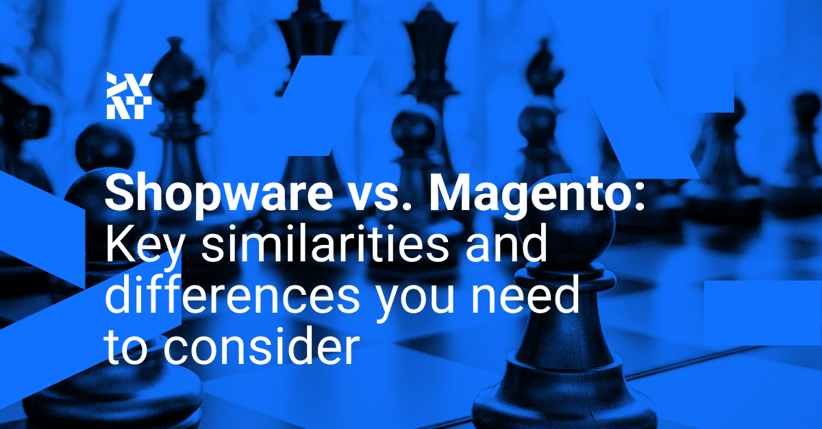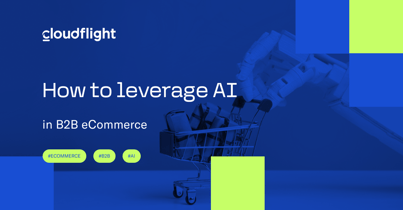When it comes to selecting an all-in-one eCommerce platform, Shopware and Magento are popular choices that offer all the features you need straight out of the box. Tens of thousands successful stores are currently running on them, and thanks to their great potential to scale, they can be successfully used in projects of nearly any scope.
So, which one is the better fit for your unique eCommerce needs? What do they have in common, and where do they differ? In this article, we’ll take a look at the unique features of each platform and help you choose the right system to take your business to the next level.
What Shopware and Magento have in common
Both Shopware and Magento, now officially known as Adobe Commerce, are complete eCommerce platforms with all the key back-end and front-end systems already in place straight out of the box. They’re easy to expand and customize through community-created plugins and themes available on dedicated marketplaces.
Tech and business models
Shopware and Magento both take advantage of headless architecture, which, according to our eCommerce Trend Radar, is currently among six of the hottest trends in eCommerce. Headless platforms are solid choices for most large and enterprise-level projects. The only way to go up from there is a composable solution. Depending on your needs, both can be implemented either as a self-hosted open-source tech or as a cloud-hosted SAAS with plenty of pricing plans to choose from.
Multi-store solutions
These are great solutions if you’re planning to set up multiple stores. Both Shopware and Magento allow you to set up different front ends that all connect to a single back end. This will be especially useful if you’re running a business that sells products under multiple brands that need their own unique stores. Another use case is running multiple localized versions of a given store for different markets. You can set up unique inventories, content, and payment and shipping options for each one of them, but in the end, the orders will still be processed by a single centralized back end.
Unique Shopware features
Shopware is the smaller of the two compared solutions in terms of its capabilities as well as market share. It’s a popular choice for German, Austrian, Swiss, and simply put, German-speaking (DACH) eCommerce owners. It’s fairly niche everywhere else. Still, it’s a very capable platform, that comes with a few attractive and unique features, that will have no problem handling most projects.
The Shopping Experiences
The Shopping Experiences is Shopware’s built-in drag-and-drop page builder that you can use to create landing pages for marketing campaigns. Drag-and-drop builders obviously have their limits and likely won’t let you achieve the same results as a custom-designed and coded landing page. On the other hand, their main selling point is quick time to market and the ability to quickly test ideas without the need to involve developers in the process.
Another advantage of building your landing page through The Shopping Experiences is that you’re staying within the Shopware ecosystem. All the different components, such as product information, cart, checkout, etc., are right there with no need for any extra integrations that you would need to create while coding a custom landing page.
B2B Suite and file import
If you’re running a B2B store, both Shopware and Magento can support you with specialized functions in this area. They let you set up the entire structure and decision chain of your customer directly in the eCommerce ecosystem. You can, for example, determine roles and budgets, and specify who approves what kind of orders on the basis of value, product type, or a number of other criteria.
A unique feature of Shopware’s B2B Suite that you won’t find in Magento is placing orders through file import. Say your client has an Excel template they use for orders. Instead of manually pasting the order into your system and processing it, you can teach the file recognition system the logic your client uses for their template and simply upload it to Shopware. The system will handle the rest and automatically create the order. How neat is that?
"From a developer’s perspective, a notable unique feature of Shopware is the Bulk Payload. In simple terms, it allows for write operations, so, creating, updating, or deleting, on multiple products to happen simultaneously rather than one by one like it happens in Magento.
"It’s a huge performance boost when, for instance, you need to change the prices on multiple products at once, but its effects are most noticeable and a real game changer when you need to migrate the entire database."Kamil Wręczycki, Lead PHP Developer
& Shopware expert
Flow Builder
Another unique feature of Shopware is its no-code automation tool: Flow Builder. It lets you set up fairly sophisticated business flows within the eCommerce ecosystem simply by building flowcharts out of predefined event and action blocks. Say you want to send out emails asking your customers for feedback a couple of days after a purchase, define shipping and payment conditions based on the customer’s location, or automate ordering from your suppliers. These are all examples of webhook and API-based automations you can easily set up with no coding expertise.
Popularity in DACH regions
If you’re based in a DACH country, Shopware’s popularity in this region will be a huge advantage that you should also take into account. From the development and maintenance standpoint, this means you should be able to easily find help with any issues that come up. There will be extensive documentation and guides, both official and community-created, as well as plenty of experts who speak your native language. It also means that many specialized Shopware plugins created specifically for the DACH market simply don’t have a Magento counterpart.
|
Top 3 Countries |
1st place |
United States: 22,202 stores 13.6% of stores |
Germany: 25,209 stores 68.7% of stores |
|
2nd place |
United Kingdom: 12,095 stores 7.4% of stores |
Switzerland: 1,796 stores 4.9% of stores |
|
|
3rd place |
Germany: 9,882 stores 6.0% of stores |
Austria: 1,402 stores 3.8% of stores |
|
Unique Magento features
Magento is the more robust platform out of the two and has the full strength of the Adobe brand and their technology behind it. When there’s a feature that both Magento and Shopware offer, you can expect the Adobe product to take it just a step further with a little extra polish. There are also a few unique features that Shopware simply doesn’t offer.
Page Builder
In contrast to its Shopware counterpart, Magento’s drag-and-drop Page Builder tends to focus more on subpages within the main store rather than dedicated landing pages. It offers robust features that make it possible to create highly customized product and category pages suitable for your unique brand identity. Page Builder supports all content types that you can easily place in the connected content management system (CMS).
AI-powered recommendations
The Product Recommendations module is one of Magento’s strongest unique selling points. In most eCommerce platforms, there isn’t much to the recommendation feature. It will show other products from a given category or those that you manually set as related. That’s pretty much it. Magento takes this a few steps further by adding artificial intelligence (AI) and machine learning to the mix. Its recommendations are based on more sophisticated factors, like analysis of user behavior, contextual clues, and even current global trends.
Inventory management
Straight out of the box, Magento also offers more sophisticated inventory and order management solutions than its competitors. If you can fulfill a given order from more than one location, Magento’s algorithms will be able to pick the optimal warehouse based on your priorities. For instance, the location might change based on whether you set speed or time efficiency as the deciding factor. Magento also helps you keep track of precise inventory information with real-time multichannel tracking of all your products across all of your locations.
Differences in pricing models
Both Shopware and Magento offer the same starting point in their free-to-use open-source versions. These versions are obviously not for everyone. Setting up a self-hosted platform is a much more complex, labor-intensive process than simply subscribing to its cloud-based SaaS/PaaS counterpart. On the flip side, you get complete control over every aspect of the deployment.
The competing solutions approach their paid plans very differently. Shopware is the more traditional of the two. Just like with pretty much any other SaaS/PaaS, they offer three pricing plans that differ in terms of features and support level. The entry tier, Rise, will cost you $600 per month, while the next two tiers are priced individually.
Magento doesn’t have a fixed price. Your monthly fee will depend on the size of your store: in other words, its gross merchandise value (GMV) and average order value (AOV). Magento offers two plans that differ only in the level of support. All the features stay the same.
Ballpark estimations for a medium-scale Magento and Shopware project
The license itself is just the tip of the iceberg when it comes to the total costs, though. In our “Comparing Magento and Shopware in 2023” eBook, we took a closer look at how much two similar medium-scale projects based on Shopware and Magento would cost with everything included. It won’t reflect your unique needs perfectly, but it will provide you with ballpark figures of what to expect from this kind of project.
Bottom line: key points to consider when choosing your all-in-one eCommerce solution
As it usually happens with these kinds of comparisons, it’s difficult to pick a clear winner out of the two. They each offer a few unique selling points, and it’s largely up to you to pick the ones that will best support you and your individual eCommerce needs.
Shopware is a fairly niche but steadily growing platform. It’s more modest than Magento in terms of features but still offers everything you need to set up a successful store. From the development perspective, the platform is great to work with thanks to its simplicity and quick time to market. We went more in-depth into those aspects in our ikarus case study. If you’re based in the DACH region, Shopware’s popularity in those countries is also a factor you should take into consideration.
Magento is the tried and true all-in-one eCommerce solution with a market share nearly 10 times higher than Shopware. It’s what you would expect from an Adobe product: a robust polished solution that comes with a hefty price attached. Where Magento excels the most is its wide range of modules ready to use straight out of the box, and its impressive scaling capabilities. Those were the deciding factors in why we chose Magento for our Sentic project that’s described in detail in this case study.
The next step: choosing the right solution for you
Of course, features and pricing models are not the whole story here. There are many more aspects that factor in when choosing the right eCommerce solution for your business. On the technical level, you should also consider the performance, security, compatibility with other systems, and other limitations. On the business end, you might want to research the official support and user communities of those platforms, their future plans, and development strategies.
Luckily for you, we’ve already done all of this legwork. You can discover our findings in our recent eBook, “Comparing Magento and Shopware in 2023” to check which of them is a better fit for your company.
Published June 13, 2023













